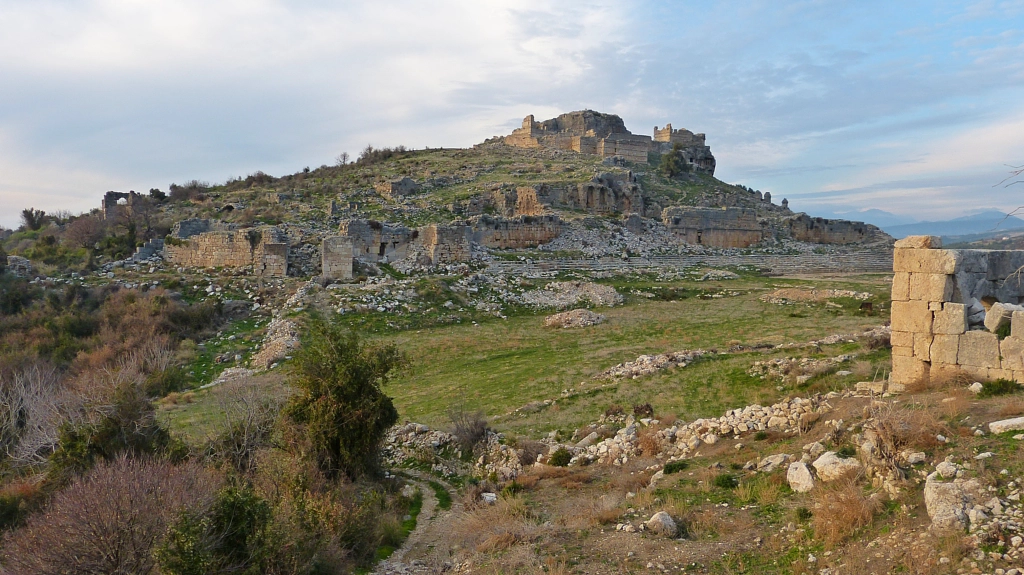History of Tlos
The historical ancient city of Tlos, located within the borders of Yaka District of Seydikemer, one of the most important settlements of Lycia; It is on the UNESCO World Heritage Tentative List and is one of the oldest settlements in the geography known as the Lycian Region. The name of the city of Tlos is derived from the Lycian word “Tlawa”. Hittite king IV. On the 14th and 15th blocks of the open-air temple orthostats, where the Lukka expedition of Tuthaliya (1250-1220 BC) is described: “I landed in the Dalawa Country. The women and children of the Dalawa Country bow down before me”, is read.
The name Tlawa, on the other hand, is identical with the “Dalawa” settlement in the territory of Lukka, which we have encountered many times in Hittite texts since the 15th century BC.
The ancient city of Tlos was accepted as one of the six largest cities of the Lycian union with three voting rights, such as Xanthos, Patara, Pinara, Olympos and Myra. In AD 43, Roman Emperor Claudius transformed the Lycia Region into a Roman province. In this period, Tlos maintained its importance in the union and continued to bear the title of Metropolis. It must have been due to this importance, as emphasized in the Road Guide Monument erected in Patara, the Lycian road network was connected to Tlos in seven different directions, from Xanthos in the south, Pinara in the southwest, Telmessos in the west, Cadianda in the northwest, Trade routes from Araxa to the north, Oinoanda to the northeast, and Choma to the east intersected at Tlos. It is also known that many of these routes are used today. During the Christian Period, Tlos was one of the important episcopacy centers of Lycia. It is documented by archaeological data that this religious importance continued until the 12th century AD. Tlos makes its importance felt within the borders of Lycia during the Ottoman Period as well. The Ottoman Overlord, who came to the region for the last time in the 19th century and became famous as “Kanlı Ali Ağa”, built his castle on the top of the Tlos Acropolis, using the ancient ruins. Today’s modern Yaka Village was built on the ancient settlement of Tlos.
The ancient settlement, which started on the steep western slopes of Akdağlar (Kragos), the highest mountains of the region, was fortified with fortifications around the acropolis hill, which is naturally sheltered with its steep slopes of about 500 meters. On the way to the Tlos castle, the temple tombs carved into the rocks on the slope attract attention. The most magnificent of these tombs is the tomb monument of Bellerephontes, where the winged horse Pegasus is depicted fighting the three-headed monster Chimera. Two columns at the entrance, a three-section wall, a door decorated with ornaments in the middle, and the doors leading to the burial chamber on both sides increase the interest in the structure. At the foot of the acropolis, there are a few rows of seats, stadium, bath, theater and church ruins. On the plain under the castle are the remains of a nine-meter-wide Lycian (Lycian) wall. In the south of the city agora, whose six-arched gate is still standing, the Roman period walls can be seen. The important structure of Tlos is the theater. However, the stadium is also of great importance. Tlos is also known as the sports city of Lycia.
The borders of the ancient city of Tlos reach the valley plain formed by the alluvium brought by the Eşen River. In addition, Saklıkent Canyon in the south and Kemer Town in the north draw the sovereignty borders of the ancient city. Among the ancient neighbors of the city, which stands out with its defensive mountainous terrain and its position overlooking the Eşen Plain, are Araxa in the north, Oinoanda in the northeast, Kadyanda in the northwest, Xanthos in the south, Pınara in the southwest and Telmessos in the west. Thus, it is understood that the settlement of Tlos spread over a wider geography than in any other Lycian city, so the expression “country” was used for Tlos instead of “city” in Hittite sources. It is known from the inscriptions that the ancient city consisted of many districts and neighborhoods, and that there were many village settlements connected to the center around it.
Tlos is the shining star of the region in terms of archaeological, cultural, religious and economic aspects in the historical process. It carries the traces of the settlement that continued uninterruptedly from the Neolithic period to the Iron Age. In fact, in the written sources of the Hittites, (Anal, Annual) Tlos is mentioned as a country. Tlos, which is an important center in terms of Christian history, is one of the most important episcopacy centers of Lycia. This religious significance continued until the 12th century. It also bears the traces of the Ottoman Period. In the 18th century, Tlos was the intersection point of the trade routes of the region.
Tlos- The Legend of Pegasus
The founding legend of Tlos; It is based on Hellenic myths and it is believed that the name of the city of Tlos comes from “Tloos”, one of the four sons of Tremilus and Praxidike. It has even been accepted that Pinaros, Xanthos and Kragos are his brothers.
According to mythology;
Goddess Athena gave the winged horse Pegasus to a valiant youth named Bellerofon, who went to fight the fire-breathing monster. Thanks to Pegasus, Bellerofon was able to reach heights beyond the reach of the monster’s flames and kill him with his arrows. After this success, he married the daughter of the Lycian King and became the heir to the throne. Tlos is the city where Yigit Bellerofon lived happily for many years. Over time, arrogant with his achievements, Bellerofon draws the anger of the gods.
As a result of his arrogance, he even tries to get on Olympos by getting on a Pegasus one day. He incurs the wrath of Zeus and a horsefly haunts Pegasus, which Bellerophontes rides. As soon as this fly, which settles under the horse’s tail, bites the horse, the horse throws Bellerophontes over. Bellerophontes, who had gone up until he disappeared from sight, fell to the ground with great speed. The hero, once the nightmare of his enemies, lives until the end of his life as a crippled and blind man cursed by the gods.
The rock tombs in Tlos, known as the place where the winged horse Pegasus and the hero Bellerophontes lived, contain rare examples of classical Lycian tomb architecture. The tomb monument of Bellerephontes, where Bellerophontes and Pegasus are depicted fighting the three-headed monster Chimera, is quite impressive.
The Most Important Buildings of the Ancient City of Tlos
Another important structure, 84 x 33 meters in size, similar to the cruciform basilica of Anatolia, is the Temple of Kronos. The temple, which was built in the Corinthian architectural style and dated to the 2nd century AD, covers an area of 15 x 7 meters. It is dedicated to the sky god Kronos, known as the god of the gods, who was the first titan and created time. In addition, there is no other temple dedicated to Kronos in Anatolia.
It is the theater, one of the two most important surviving structures of Tlos. The theater differs from other theaters in the Lycian region with its three-storey stage and two-stage cavea. Although there is no exact information, it has a capacity of 7-8 thousand people. Excavations here continue.
One of the other 2 important structures is the stadium. The stadium, which was built in the Roman period, has nine rows of seats and has a capacity of 2500 people. There is a rectangular pool in the middle of the stadium. Due to the presence of such different structures, it is said that this region is also used for religious and social purposes apart from sports activities.
There are 2 large and small baths in the ancient city of Tlos. The larger bath is also called the Seven Gates. Indeed, 7 arc (arc-arc) structures have been able to preserve themselves until today. This bath, which was built in the Early Roman Period, was converted into a church in the 11th century AD. Therefore, this region is also of great importance for Christianity.
One of the most interesting points of the city is the Necropolis. The tombs, which have an ostentatious arrangement, were carved into the bedrock. There are not only chamber burials, but also Lycian type closed sarcophagi and sarcophagi with a triangular pediment and lid, which were used in the Roman period.
Excavations continue in Tlos, one of the largest Lycian cities of the period.
The ancient city of Tlos in the district of Seydikemer, which is among the important settlements of the Lycian civilization, is one of the places you should see if you go to Fethiye. If you like to visit ancient cities, you should also visit Xanthos, Myra, Olympos, Patara, Pınara, other valuable Lycian ancient cities.
Where is Tlos Ancient City?
It is located in Kale Neighborhood in Yaka Village, 50 km from Fethiye and 14 km from Seydikemer.
Tlos Ancient City Visit Information
April 15 / October 2 Summer Visit Opening Time: 09:00 Closing Time: 19:00
October 3 / April 14 Winter Visit Opening Time: 09:00 Closing Time: 18:00
Holiday Day: NO
Entry Fee: 6 TL Click for Visit Information Source








Trackbacks/Pingbacks